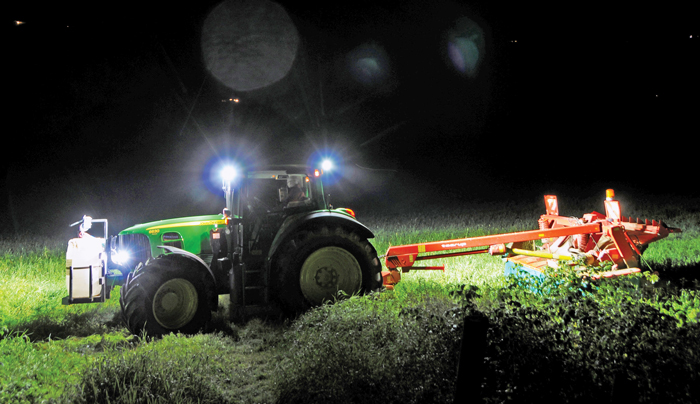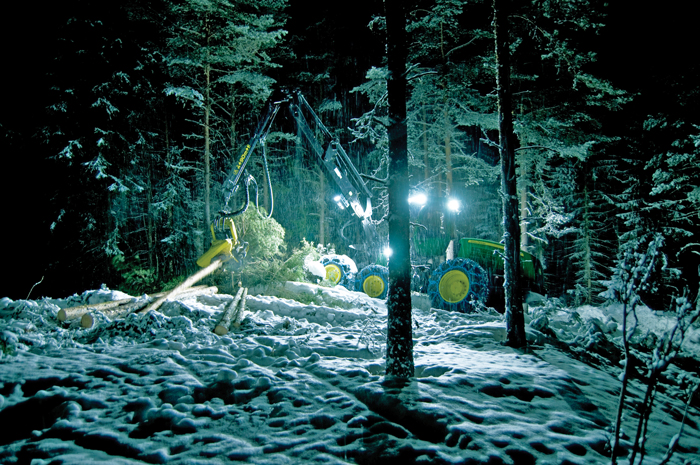A Clearer Vision
A common concern with OEMs, distributors, fleet managers, machine owners and machine operators is how to maintain operator safety and the safety of others during a workday, especially in dimly lit areas and during night hours. Whether the equipment is used for construction, landscaping, farming or a different industry entirely, lighting is a large contributing factor to safely operate equipment in less than ideal conditions since you cannot prevent what cannot be seen.
Proper equipment lighting should allow operators to clearly see the surrounding environment with a focus on the primary work area while not producing a hindering glare for themselves or others in the workplace. Throughout the years, lighting has made multiple advancements through materials used, methods of production and, most importantly, the lighting technology. The three primary lighting technologies are Halogen, HID (Xenon) and LED.
Halogen lighting, the oldest of the three technologies, uses a filament in the bulb which emits light when electric current is passed through. HID (High Intensity Gas Discharge) lighting, also known as Xenon, uses a capsule of gas in place of the filament used in halogen technology. The light emits from an arc discharge between two closely spaced electrodes sealed inside a small quartz glass capsule. To operate, an HID light requires a ballast, which supplies the proper voltage and control current. HIDs produce four to five times greater light output, consume less power and create a color spectrum closer to daylight than Halogen technology.

LED and HID lights contain circuitry, which could influence other electronic devices if they are not tested to industry standards for Electromagnetic Compatibility (EMC). When electronic devices are interconnected and/or in close proximity to each other, they influence each other. The influence creates interference and is apparent to a person, for example by hearing “noise” on a radio or viewing a “fuzzy” monitor. This interference creates an unsafe working environment since the operator may not be able to see a person, object or unsafe terrain in the monitor when backing up or hear a co-worker yelling “STOP” on the radio. The purpose of EMC is to reduce the interference to an insignificant and nearly undetectable amount that allows other electronics on the equipment to operate properly as designed.
The three primary factors of lighting safety is light output, light placement on equipment and light color. To begin with and better understand light output, Luminous Flux is the total operating output of a light which is expressed in Lumens. The larger the number of Lumens, the greater the output of the light. LED output is typically referred to in two separate categories: Theoretical and Operating. Theoretical Lumens refers to the output the light would have if there would not be any loss of light through the electrical components, heat generated during operation, reflectors and lenses. The Operating Lumens refers to the “real life” output the light has while being used and is the reason why the value is lower in comparison to the Theoretical Lumens. Users of LED lighting in today’s marketplace should always compare LED lights based on Operating Lumens when making purchasing decisions to avoid incompatible comparisons of Theoretical Lumens, since there is neither an industry standard nor governing agency to establish a standard way of computing the theoretical.
Placement of lights on equipment is another critical factor when considering safety of operators and others. Equipment often creates shadows and blind spots during operation at night and dimly lit areas. Lighting manufacturers have on-staff engineers who conduct Photometric Analysis regularly to ensure the placement of the light is effective and offers clear visibility for the operator to work efficiently and safely. The technologically advanced software used by the engineers allows the equipment’s design features, operation and any parts which may obstruct the light, to be calculated into the analysis to determine the proper placement and output of lighting.
In the past, lights on the cabs of equipment were sufficient; however with today’s technology, lights can be integrated into the design and placed in locations such as booms to follow the movement of the boom and see what the attachment is working on. This allows OEMs to see how the given light and equipment design will perform prior to manufacturing the equipment.
Color temperature is a characteristic of visible light measured by the Kelvin (K) scale. Generally, the human eye functions more effectively when viewing objects illuminated by a light source whose color temperature is closest to the white to light blue color emitted by the mid-day sun (5,400K). LED lights range from 5,000K to 6,000K, whereas HID is 4,200K and Halogen is 3,000K creating an orange-yellowish color light with the lower Kelvin temperatures. Color temperature is an advantage LED lights have over HID and Halogen technologies. From a work perspective, this translates to a safer and more productive work environment.
Lighting output, light placement and color temperature are all used to reduce the glare from the equipment and surrounding environment for the operator and others. Glare can be caused and fixed by adjusting each of these aspects based on the application. It is possible to have too bright of a light causing glare off dust in the air or the boom of an excavator. Adjusting the output of the light or possibly even the color temperature of the light could improve the visibility for the operator if the amount of dust in the air is the problem.
If the boom is obstructing the light and creating glare, the best option would be to move the location of the light. When that is not an option, using a light with less output to reduce the glare while allowing the operator sufficient visibility of the workplace could be the solution. Personnel are in place from distributors, dealerships, OEMs and lighting manufacturers to assist with creating solutions to increase workplace safety through use of proper lighting.
In the future, lighting safety will only improve with the technology of automated features and sensors incorporated into the OEMs’ electrical systems, allowing the operators to have clearer vision and focus on their tasks at hand, instead of manually turning on, dimming or adjusting the equipment’s lights.
Clayton Foster is the business development manager at TYRI Lights, based in Stevens Point, Wis.

